‘Extremely rare’ BLUE supermoon to light up skies tonight – now’s the best time to see the stunning lunar show
Avid stargazers can expect a rare surprise tonight: a blue supermoon will light up the sky.
A supermoon occurs only three or four times a year, when the moon is closest to Earth.
This makes our lunar satellite appear up to 14 percent larger and a third brighter than normal, resulting in truly spectacular images over the next three days when the moon is full.
This lunar appearance is even rarer than a standard supermoon, as it coincides with the first blue moon since August last year and will appear dark red due to ash from wildfires in the atmosphere.
But make sure you look closely tonight, because the blue supermoon won’t be seen again until 2037.
Stargazers are in for an exceptionally rare treat tonight as a blue supermoon lights up the Northern Hemisphere. Pictured is the blue supermoon over Sydney today
The moon’s orbit around the earth is not completely circular, but follows an elliptical pattern. This causes the distance between the two planets to change as the year progresses.
Normally the Moon orbits the Earth at a distance of about 384,000 km, but its closest point, or perigee, is considerably closer.
When a full moon is less than 90 percent of its closest point to Earth, it is called a supermoon.
Tonight, the moon will be 23,000 kilometers closer than normal, almost twice the diameter of the Earth.
From our perspective on Earth, this makes the Moon appear larger and brighter in the sky.
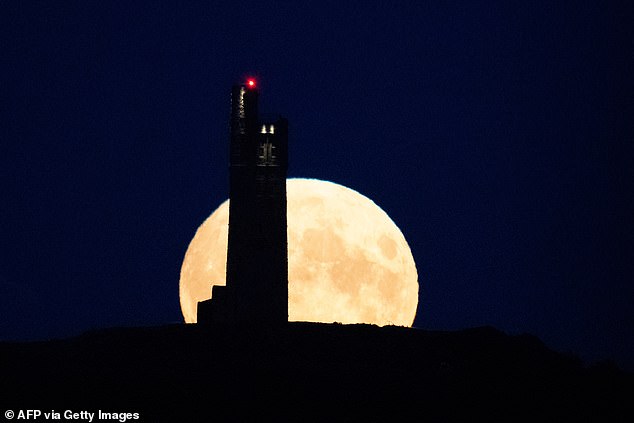
A supermoon refers to a full moon that occurs when the moon is at its closest to the Earth. In the photo, the latest full blue supermoon rises over Victoria Tower in Huddersfield
A Blue Moon occurs once every two or three years and refers to the second full moon in a calendar month or the third full moon in a four-moon season, as is the case tonight.
However, the fact that it is a blue moon does not mean that the color of the moon will appear blue.
Tonight the Moon will likely appear red due to the presence of ash particles in the upper atmosphere.
Wildfires in North America have sent ash into the upper atmosphere. This ash is carried by the jet stream to the United Kingdom, where it scatters the sun’s light.
Because the axis mainly transmits long-wave red light, the sun and moon both appear to take on a reddish color.
It is rare for the moon to turn blue due to volcanic dust entering the atmosphere. However, this has nothing to do with the term ‘blue moon’ as it is used today.
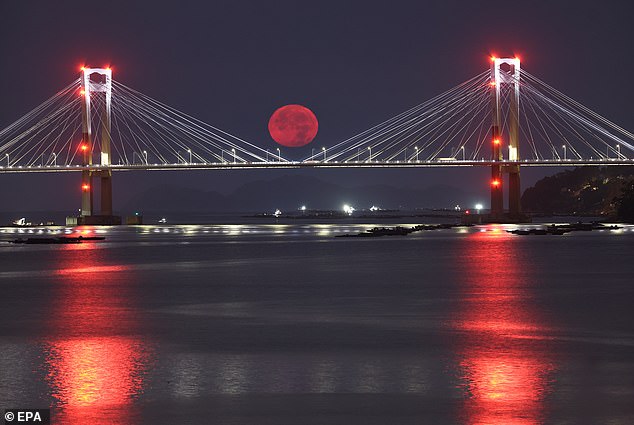
Tonight’s display will be even more impressive as dust from wildfires turns the moon a deep red. In the photo, the moon rises over the Rande Bridge in Vigo, Spain
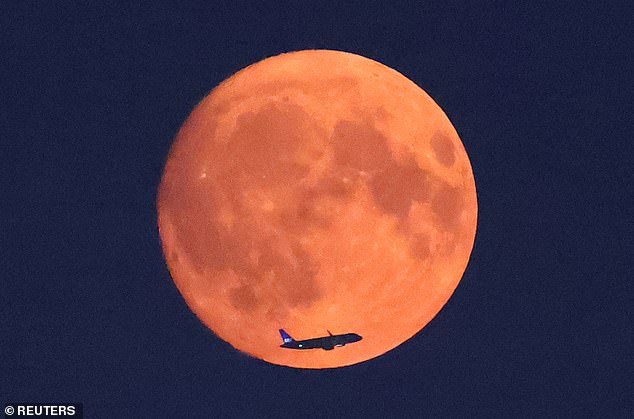
When smoke in the atmosphere scatters the light from the moon, it takes on a striking red hue. Pictured, the moon seen last night from Parliament Hill, London
It has been suggested that the term Blue Moon derives from the Old English word ‘belewe’, meaning ‘to betray’, as a Blue Moon would make it difficult to calculate the timing of Lent.
Supermen occur about three or four times a year. The next ones are on August 18, October 17 and November 16.
However, it is rare for a supermoon to fall on the same day as a blue moon.
The last time this happened was on August 31st of last year, but if you miss tonight’s blue supermoon, you’ll have to wait until 2037 for the next one.
With nights still quite short across the UK and much of the Northern Hemisphere, it’s important to get out at the right time to have a good chance of seeing tonight’s blue supermoon.
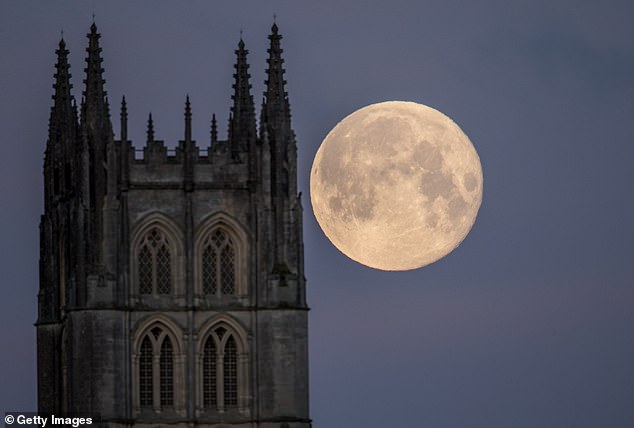
There have been blue supermoons in 2023 and 2018 (pictured above Downside Abbey in Somerset). Before that, the last blue supermoon was in 1866
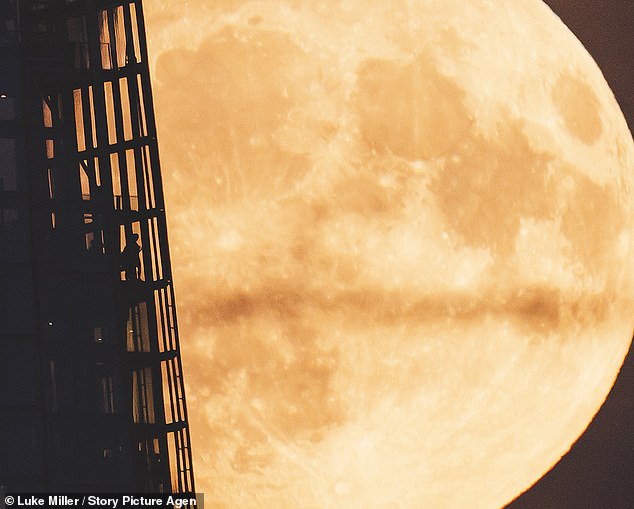
If you miss the blue supermoon over the next three days, the next chance to see one will be in 2037. Pictured here is a blue moon rising over the Shard in London on Saturday
When the moon is low on the horizon, we experience it as larger than it actually is. This is due to a phenomenon called the ‘moon illusion’.
By looking at the moon shortly after sunrise, you can use this effect to your advantage and get even more spectacular images.
Professor Richard de Grijs from Macquarie University told The guard: ‘It actually appears largest at dusk, because of the way the light reflects off the atmosphere.
“If you want to see a larger than normal moon, look toward the horizon at sunset today.”
The moon rises tonight around 8:30pm (BST), shortly after the sun sets over England.
To see the moon while it is still low on the horizon, it is best to go out around sunset and find a spot with a good view of the horizon.
Because the moon is very low at this time, it is much more difficult to see anything through buildings and trees.
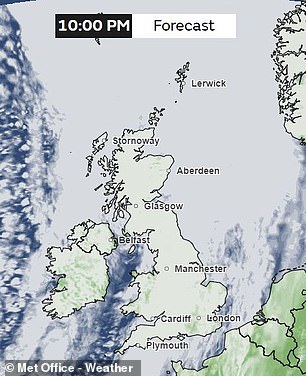
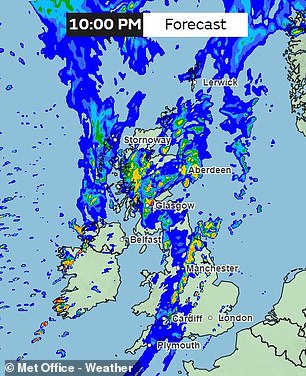
Unfortunately the weather tonight won’t be great for stargazing, with the Met Office predicting cloud and rain across much of the country.
But because the Moon is at its largest and brightest, it should be clearly visible all evening, provided the sky is clear.
You don’t need any special equipment to get a good view, but beginning astronomers can use binoculars or a small telescope to spot some of the moon’s features.
Unfortunately, the Met Office weather forecast for tonight does not predict conditions to be ideal.
At 22:00 (BST) most of the country is covered in thick cloud, with only a few small showers over London and south-east England.
Meanwhile, rain is forecast across the west of the UK, from Cornwall to Scotland, throughout the evening and into the early hours of the morning.
Met Office spokesperson Andrea Bishop told MailOnline: ‘The weather forecast isn’t looking too good tonight, with cloud and showers spreading eastwards across the UK.
‘The supermoon may be visible in the far east of East Anglia and south-east England before the clouds close in. In the early hours of the morning, skies will clear in the north and west, allowing the moon to be visible until sunrise.’
However, the full moon will remain for three more days, so better opportunities may arise later in the week.
